Hierarchical Ag3VO4 Nanorods as an Excellent Visible Light Photocatalyst for CO2 Conversion to Solar Fuels
Abstract
:1. Introduction
2. Results and Discussion
2.1. Catalyst Characterization
2.2. Photocatalytic Activity and Stability
2.3. Reaction Mechanism
3. Experimental Section
3.1. Chemicals
3.2. Synthesis of Ag3VO4 Nanorods
3.3. Material Characterization
3.4. Photocatalytic Activity Test
4. Conclusions
Author Contributions
Funding
Data Availability Statement
Acknowledgments
Conflicts of Interest
References
- Kong, N.; Du, H.; Li, Z.; Lu, T.; Xia, S.; Tang, Z.; Song, S. Nano heterojunction of double MOFs for improved CO2 photocatalytic reduction performance. Colloids Surf. A Physicochem. Eng. Asp. 2023, 663, 131005. [Google Scholar] [CrossRef]
- Ma, L.; Guan, R.; Kang, W.; Sun, Z.; Li, H.; Li, Q.; Shen, Q.; Chen, C.; Liu, X.; Jia, H. Preparation of highly dispersed Ni single-atom doped ultrathin g-C3N4 nanosheets by metal vapor exfoliation for efficient photocatalytic CO2 reduction. J. Colloid Interface Sci. 2024, 660, 381–392. [Google Scholar] [CrossRef] [PubMed]
- Bafaqeer, A.; Amin, N.A.S.; Ummer, A.C.; Ahmed, S.; Al-Qathmi, A.T.; Usman, J.; Kulal, N.; Tanimu, G. Well-designed glucose precursor carbon/g-C3N4 nanocomposite for enhanced visible light photocatalytic CO2 reduction activity. J. Photochem. Photobiol. A 2024, 447, 115272. [Google Scholar] [CrossRef]
- Cao, J.; Wang, J.; Wang, Z.; Zubairu, S.M.; Ding, Y.; Zhu, G. In-situ construction of Z-scheme 2D/2D g-C3N4/BiOBr heterojunction with enhanced photocatalytic CO2 reduction. Surf. Interfaces 2024, 45, 103875. [Google Scholar] [CrossRef]
- Xu, M.; Chen, C.; Han, X.; Hu, W.; Li, B. Synchronous Construction of Cu and Ni Single-atom Sites in Ordered Porous TiO2 for Enhanced Photo-Conversion of CO2 and H2O to Methane. Colloids Surf. A Physicochem. Eng. Asp. 2024, 688, 133676. [Google Scholar] [CrossRef]
- Duraisami, D.; Al-Harthi, M.A.; Ramya, B.; Baskaran, D.; Elakkiya, M.; Bafaqeer, A. Metal organic frameworks: Building blocks for a greener future. J. Clean. Prod. 2024, 451, 142057. [Google Scholar] [CrossRef]
- Khan, A.A.; Tahir, M.; Khan, N. Process optimization and kinetic study for solar-driven photocatalytic methane bi-reforming over TiO2/Ti3C2 supported CoAlLa-LDH-g-C3N4 dual S-scheme nanocomposite. Energy Convers. Manag. 2023, 286, 117021. [Google Scholar] [CrossRef]
- Lv, Y.; Li, P.; Chen, X.; Wang, D.; Xiao, M.; Song, H.; Gao, J.; Shang, Y. Photo-induced surface oxygen vacancy in hierarchical nanoarchitectonics g-C3N4/BiOCOOH to boost photocatalytic CO2 reduction. J. Mol. Struct. 2024, 1297, 136961. [Google Scholar] [CrossRef]
- Raza, A.; Haidry, A.A.; Yao, Z.; Saleem, M.F.; Alothman, A.A.; Mohammad, S. Synergistic effect of CuO and Sr doped g-C3N4 for CO2 photoreduction into hydrocarbon fuels. J. Chem. Eng. 2024, 480, 148162. [Google Scholar] [CrossRef]
- Bafaqeer, A.; Tahir, M.; Amin, N.A.S.; Thabit, H.A.; Ummer, A.C. Fabrication of reduced graphene oxide (rGO) mediated ZnV2O6 nanosheets for enhancing photocatalytic CO2 reduction under UV and solar light irradiation. Inorg. Chem. Commun. 2023, 155, 110993. [Google Scholar] [CrossRef]
- Zhang, H.; Bian, H.; Wang, F.; Zhu, L.; Zhang, S.; Xia, D. Enhanced photocatalytic reduction of CO2 over pg-C3N4-supported TiO2 nanoparticles with Ag modification. Colloids Surf. A Physicochem. Eng. Asp. 2023, 674, 131989. [Google Scholar] [CrossRef]
- Khan, A.A.; Tahir, M.; Khan, N. LDH-based nanomaterials for photocatalytic applications: A comprehensive review on the role of bi/trivalent cations, anions, morphology, defect engineering, memory effect, and heterojunction formation. J. Energy Chem. 2023, 84, 242–276. [Google Scholar] [CrossRef]
- Chen, Z.; Xiong, J.; Cheng, G. Recent advances in brookite phase TiO2-based photocatalysts toward CO2 reduction. Fuel 2024, 357, 129806. [Google Scholar] [CrossRef]
- Tahir, M.; Ali Khan, A.; Bafaqeer, A.; Kumar, N.; Siraj, M.; Fatehmulla, A. Highly Stable Photocatalytic Dry and Bi-Reforming of Methane with the Role of a Hole Scavenger for Syngas Production over a Defective Co-Doped g-C3N4 Nanotexture. Catalysts 2023, 13, 1140. [Google Scholar] [CrossRef]
- Gawal, P.M.; Golder, A.K. Vegetal route for synthesis of CQDs/CdS nanocomposites for photocatalytic reduction of CO2 to methanol under visible light. Colloids Surf. A Physicochem. Eng. Asp. 2024, 683, 133068. [Google Scholar] [CrossRef]
- Dhamodharan, D.; Al-Harthi, M.A.; Ramya, B.; Bafaqeer, A.; Alam, F. MXenes: A Promising Material with Multifunctional Applications. J. Environ. Chem. Eng. 2024, 12, 112316. [Google Scholar] [CrossRef]
- Zhou, D.; Zhang, X.; Li, Z.; Zhang, J.; Wang, T.; Cao, S. Construction of local coordination environment of iron sites over g-C3N4/PCN-222 (Fe) composite with high CO2 photoreduction performance. Appl. Catal. B 2024, 344, 123639. [Google Scholar] [CrossRef]
- Gao, Y.; Wang, Y.; Sun, R.; Luo, Y.; Xin, L.; Wang, D. Interfacial hot electron injection in Cu2O/MXene-g-C3N4 pn heterojunction for efficient photocatalytic CO2 reduction. Colloids Surf. A Physicochem. Eng. Asp. 2024, 684, 133236. [Google Scholar] [CrossRef]
- Bafaqeer, A.; Tahir, M.; Amin, N.A.S.; Ummer, A.C.; Thabit, H.A.; Dhamodharan, D.; Ahmed, S.; Kumar, N. Performance analysis of rGO-bridged g-C3N4/ZnV2O6 S-scheme heterojunction for CO2 photoreduction with H2O in an externally reflected photoreactor. J. Alloys Compd. 2023, 968, 171833. [Google Scholar] [CrossRef]
- Fu, H.; Liu, X.; Wu, Y.; Zhang, Q.; Wang, Z.; Zheng, Z.; Cheng, H.; Liu, Y.; Dai, Y.; Huang, B. Construction of a bismuth-based perovskite direct Z-scheme heterojunction Au-Cs3Bi2Br9/V2O5 for efficient photocatalytic CO2 reduction. Appl. Surf. Sci. 2023, 622, 156964. [Google Scholar] [CrossRef]
- Li, Z.; Bai, W.; Liu, D.; Han, B.; Liang, Y.; Qi, J. Preloaded oxygen vacancy conditioning Ni/TiO2 to enhance photocatalytic CO2 reduction. Sep. Purif. Technol. 2024, 330, 125250. [Google Scholar] [CrossRef]
- Bafaqeer, A.; Amin, N.A.S.; Tahir, M.; Ummer, A.C.; Thabit, H.A.; Theravalappil, R.; Usman, J.; Ahmad, N. Construction of glucose precursor carbon/TiO2 heterojunction with high ligand-to-metal charge transfer (LMCT) for visible light driven CO2 reduction. Chem. Eng. Res. Des. 2024, 201, 353–361. [Google Scholar] [CrossRef]
- Guo, X.; Qiu, C.; Zhang, Z.; Zhang, J.; Wang, L.; Ding, J.; Zhang, J.; Wan, H.; Guan, G. Coaxial electrospinning prepared Cu species loaded SrTiO3 for efficient photocatalytic reduction of CO2 to CH3OH. J. Environ. Chem. Eng. 2024, 12, 111990. [Google Scholar] [CrossRef]
- Shao, X.; Li, K.; Li, J.; Cheng, Q.; Wang, G.; Wang, K. Investigating S-scheme charge transfer pathways in NiS@Ta2O5 hybrid nanofibers for photocatalytic CO2 conversion. Chin. J. Catal. 2023, 51, 193–203. [Google Scholar] [CrossRef]
- Thabit, H.A.; Sayyed, M.; Es-soufi, H.; Bafaqeer, A.; Ismail, A.K. Insights into the influence of Bi2O3 on the structural and optical characteristics of novel Bi2O3–B2O3–TeO2–MgO–PbO glasses. Opt. Quantum Electron. 2024, 56, 332. [Google Scholar] [CrossRef]
- Li, J.; Wang, Y.; Wang, Y.; Guo, Y.; Zhang, S.; Song, H.; Li, X.; Gao, Q.; Shang, W.; Hu, S. MXene Ti3C2 decorated g-C3N4/ZnO photocatalysts with improved photocatalytic performance for CO2 reduction. Nano Mater. Sci. 2023, 5, 237–245. [Google Scholar] [CrossRef]
- Thabit, H.A.; Kabir, N.A.; Al Mutairi, A.M.; Bafaqeer, A.; Alraddadi, S.; Jaji, N.-D.; Sayyed, M.; Al-Ameri, S.M. Investigation of the thermoluminescence dosimeter characteristics of multilayer ZnO (300 nm)/Ag (50 nm)/ZnO (x) thin films for photonic dosimetry applications. Opt. Mater. 2023, 137, 113548. [Google Scholar] [CrossRef]
- Abdurabu Thabit, H.; Ismail, A.K.; Kabir, N.A.; Abu Mhareb, M.H.; Al Mutairi, A.M.; Bafaqeer, A.; Alajerami, Y.; Abualsayyed, M.I. Photoluminescence and thermoluminescence dosimetry properties of Ag/Y co-doped ZnO nanophosphor for radiation measurements. Luminescence 2024, 39, e4683. [Google Scholar] [CrossRef]
- Chico-Vecino, M.; Murillo-Sierra, J.; Pino-Sandoval, D.; Hinojosa-Reyes, L.; Maya-Treviño, M.; Contreras, D.; Hernández-Ramírez, A. Preparation of WO3/In2O3 heterojunctions and their performance on the CO2 photocatalytic conversion in a continuous flow reactor. J. Environ. Chem. Eng. 2023, 11, 110372. [Google Scholar] [CrossRef]
- Liu, Y.; Dong, X.; Yuan, Q.; Liang, J.; Zhou, Y.; Qu, X.; Dong, B. In-situ synthesis of WO3–x/MoO3–x heterojunction with abundant oxygen vacancies for efficient photocatalytic reduction of CO2. Colloids Surf. A Physicochem. Eng. Asp. 2021, 621, 126582. [Google Scholar] [CrossRef]
- Zhao, M.; Qin, J.; Wang, N.; Zhang, Y.; Cui, H. Reconstruction of surface oxygen vacancy for boosting CO2 photoreduction mediated by BiOBr/CdS heterojunction. Sep. Purif. Technol. 2024, 329, 125179. [Google Scholar] [CrossRef]
- Espinosa, R.; Manríquez, M.E.; Trejo-Valdez, M.; Tzompantzi, F.; Bustos, A.F.; Ortiz-Islas, E. Synthesis and characterization of V2O5-Ga2O3 photocatalysts and their application on the photocatalytic reduction of CO2. Environ. Sci. Pollut. Res. 2023, 30, 54119–54129. [Google Scholar] [CrossRef] [PubMed]
- De, A.K.; Kamal, N.; Kumar, U.; Jatav, N.; Sinha, I. The bandgap of sulfur-doped Ag2O nanoparticles. Phys. Chem. Chem. Phys. 2023, 25, 2320–2330. [Google Scholar] [CrossRef] [PubMed]
- Padilla Villavicencio, M.; Escobedo Morales, A.; Ruiz Peralta, M.D.L.; Sánchez-Cantú, M.; Rojas Blanco, L.; Chigo Anota, E.; Camacho García, J.H.; Tzompantzi, F. Ibuprofen photodegradation by Ag2O and Ag/Ag2O composites under simulated visible light irradiation. Catal. Lett. 2020, 150, 2385–2399. [Google Scholar] [CrossRef]
- Zhang, Y.; Xu, Z.; Wang, Q.; Hao, W.; Zhai, X.; Fei, X.; Huang, X.; Bi, Y. Unveiling the activity origin of ultrathin BiOCl nanosheets for photocatalytic CO2 reduction. Appl. Catal. B 2021, 299, 120679. [Google Scholar] [CrossRef]
- Lin, C.-C.; Liu, T.-R.; Lin, S.-R.; Boopathi, K.M.; Chiang, C.-H.; Tzeng, W.-Y.; Chien, W.-H.C.; Hsu, H.-S.; Luo, C.-W.; Tsai, H.-Y. Spin-polarized photocatalytic CO2 reduction of Mn-doped perovskite nanoplates. J. Am. Chem. Soc. 2022, 144, 15718–15726. [Google Scholar] [CrossRef] [PubMed]
- Yu, M.; Lv, X.; Idris, A.M.; Li, S.; Lin, J.; Lin, H.; Wang, J.; Li, Z. Upconversion nanoparticles coupled with hierarchical ZnIn2S4 nanorods as a near-infrared responsive photocatalyst for photocatalytic CO2 reduction. J. Colloid Interface Sci. 2022, 612, 782–791. [Google Scholar] [CrossRef]
- Mkhalid, I.A.; Ismail, A.A.; Hussein, M.A.; Al Thomali, R.H. Enhanced photocatalytic performance of mesoporous TiO2 by incorporating Ag3VO4 nanoparticles for degradation of tetracycline under visible light. J. Mater. Sci. Mater. Electron. 2023, 34, 784. [Google Scholar] [CrossRef]
- Bafaqeer, A.; Ummer, A.C.; Benaafi, M.; Usman, J.; Dhamodharan, D.; Abba, S.I.; Thabit, H.A. Constructing type II heterojunction of 2D/1D Pg-C3N4/Ag3VO4 nanocomposite with high interfacial charge separation for boosting photocatalytic CO2 reduction under solar energy. J. Alloys Compd. 2024, 1007, 176505. [Google Scholar] [CrossRef]
- Nagamuthu, S.; Vijayakumar, S.; Ryu, K.-S. Synthesis of Ag anchored Ag3VO4 stacked nanosheets: Toward a negative electrode material for high-performance asymmetric supercapacitor devices. J. Phys. Chem. C 2016, 120, 18963–18970. [Google Scholar] [CrossRef]
- Gao, M.; Sun, L.; Ma, C.; Li, X.; Jiang, H.; Shen, D.; Wang, H.; Huo, P. Constructed Z-scheme g-C3N4/Ag3VO4/rGO photocatalysts with multi-interfacial electron-transfer paths for high photoreduction of CO2. Inorg. Chem. 2021, 60, 1755–1766. [Google Scholar] [CrossRef] [PubMed]
- Bhatia, P.; Dharaskar, S.; Unnarkat, A.P. CO2 reduction routes to value-added oxygenates: A review. Environ. Sci. Pollut. Res. Int. 2021, 28, 61929–61950. [Google Scholar] [CrossRef] [PubMed]
- Alshaikh, H.; Al-Hajji, L.; Mahmoud, M.H.H.; Ismail, A.A. Visible-light-driven S-scheme mesoporous Ag3VO4/C3N4 heterojunction with promoted photocatalytic performances. Sep. Purif. Technol. 2021, 272, 118914. [Google Scholar] [CrossRef]
- Cui, Y.; Zhang, P.; Li, M.; Lin, C.; Wang, Y. Z-scheme silver-based pn junction of AgFeO2-modified Ag3VO4 with enhanced photocatalytic performance. J. Alloys Compd. 2022, 918, 165771. [Google Scholar] [CrossRef]
- Li, X.; Hu, T.; Zhang, J.; Dai, K.; Liang, C. Novel 2D SnNb2O6/Ag3VO4 S-scheme heterojunction with enhanced visible-light photocatalytic activity. Ceram. Int. 2021, 47, 7169–7176. [Google Scholar] [CrossRef]
- Sun, H.; Qin, P.; Wu, Z.; Liao, C.; Guo, J.; Luo, S.; Chai, Y. Visible light-driven photocatalytic degradation of organic pollutants by a novel Ag3VO4/Ag2CO3 p–n heterojunction photocatalyst: Mechanistic insight and degradation pathways. J. Alloys Compd. 2020, 834, 155211. [Google Scholar] [CrossRef]
- Mei, F.; Dai, K.; Zhang, J.; Li, W.; Liang, C. Construction of Ag SPR-promoted step-scheme porous g-C3N4/Ag3VO4 heterojunction for improving photocatalytic activity. Appl. Surf. Sci. 2019, 488, 151–160. [Google Scholar] [CrossRef]
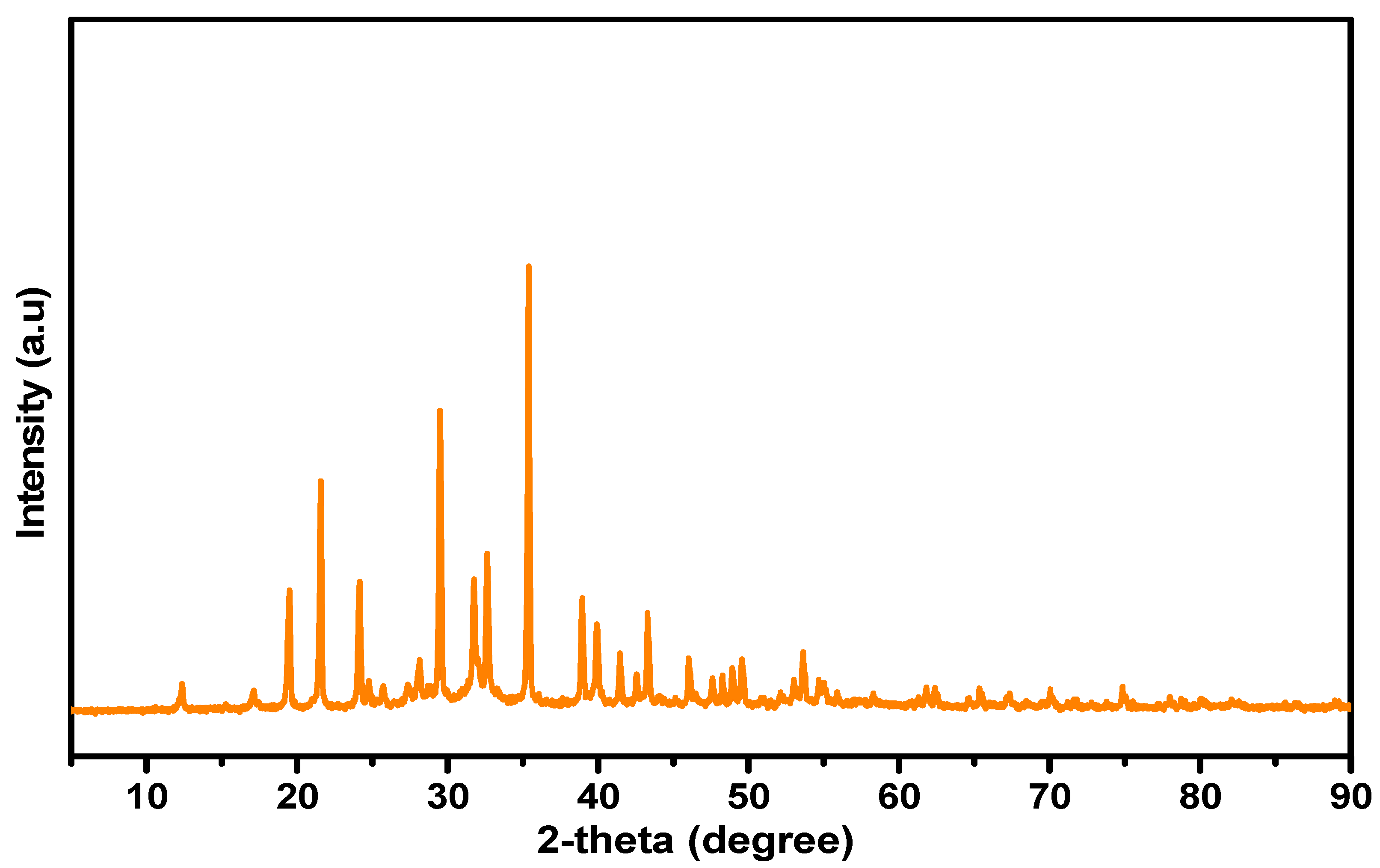





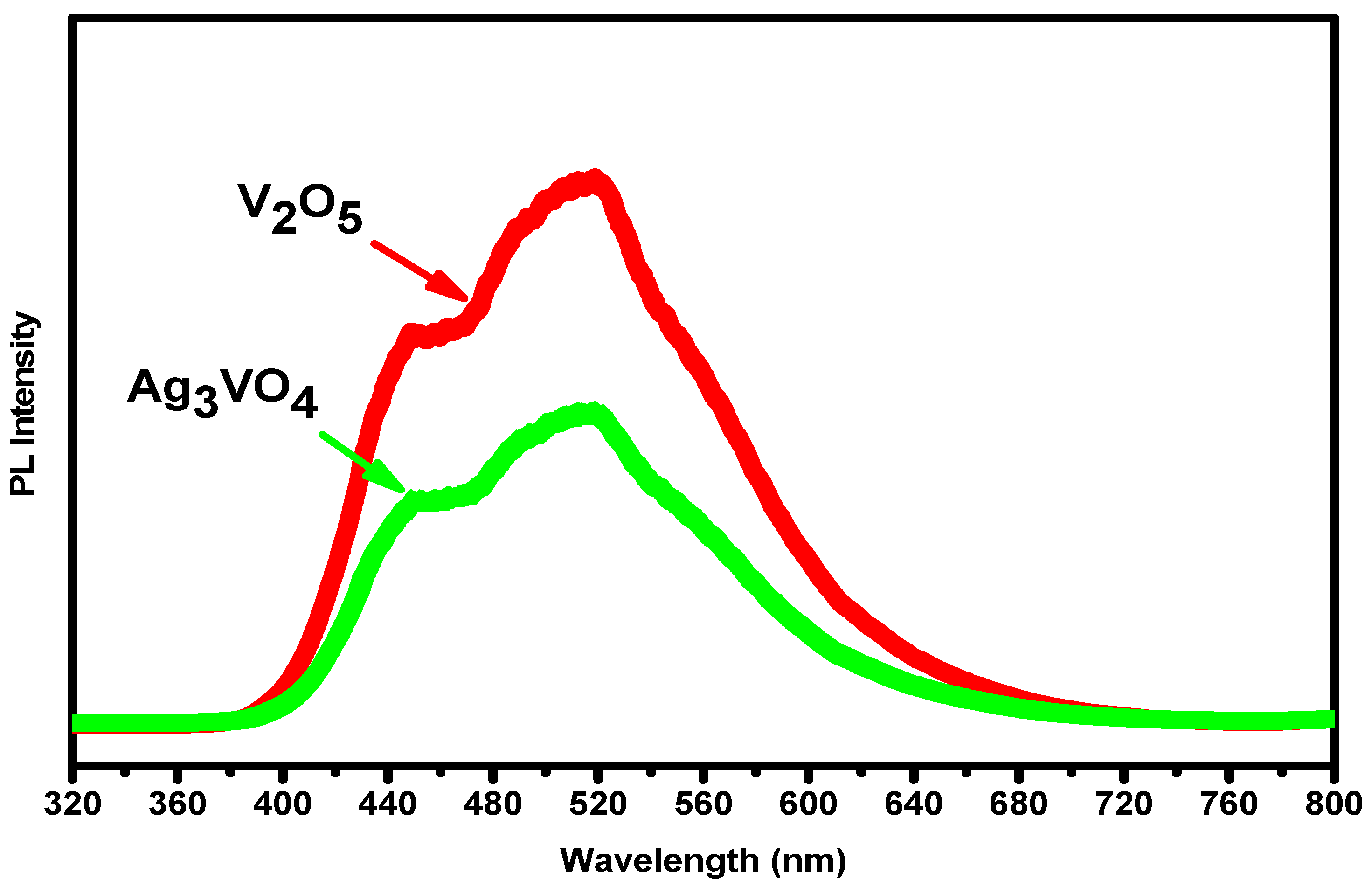
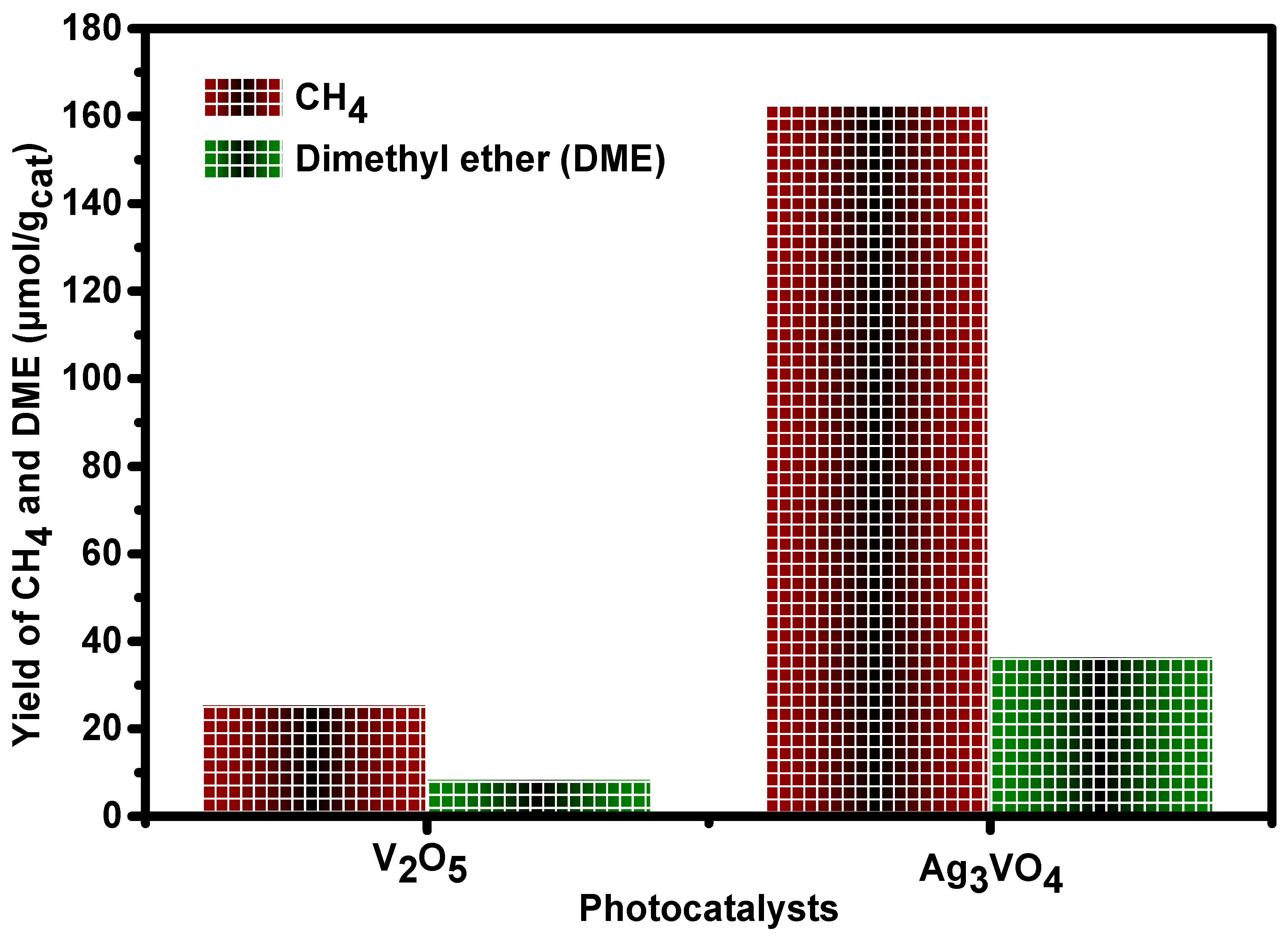
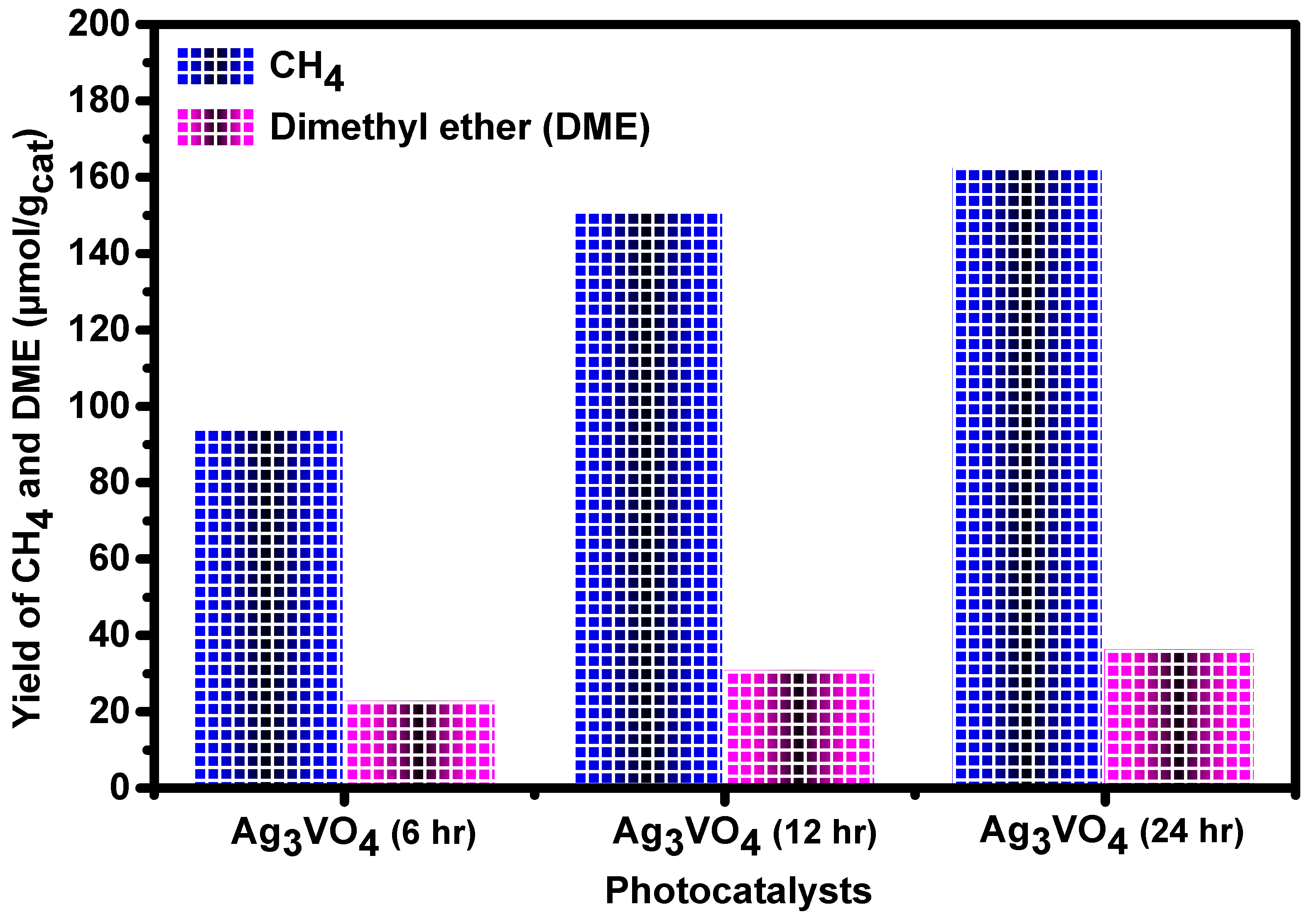

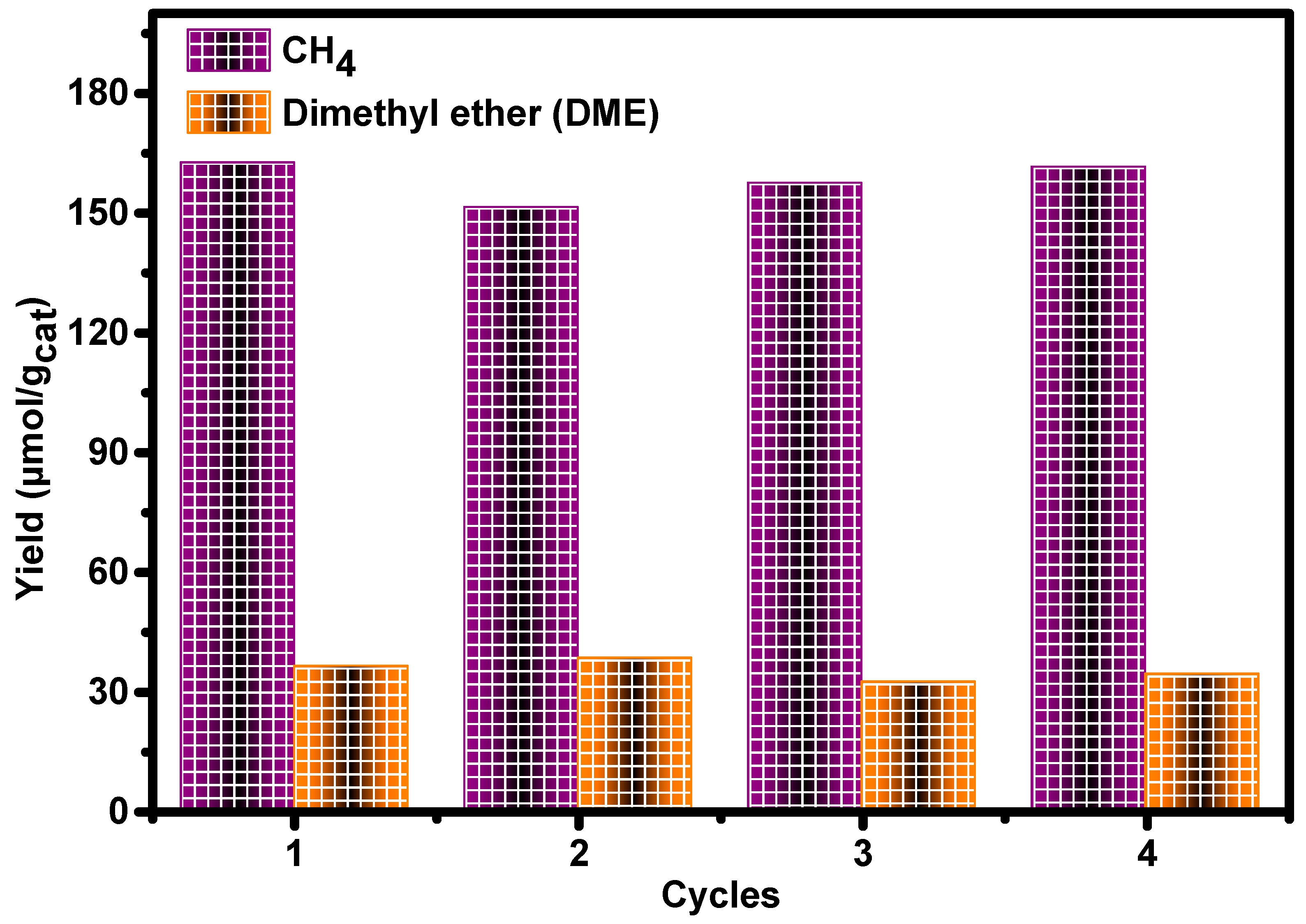


Disclaimer/Publisher’s Note: The statements, opinions and data contained in all publications are solely those of the individual author(s) and contributor(s) and not of MDPI and/or the editor(s). MDPI and/or the editor(s) disclaim responsibility for any injury to people or property resulting from any ideas, methods, instructions or products referred to in the content. |
© 2024 by the authors. Licensee MDPI, Basel, Switzerland. This article is an open access article distributed under the terms and conditions of the Creative Commons Attribution (CC BY) license (https://creativecommons.org/licenses/by/4.0/).
Share and Cite
Bafaqeer, A.; Chennampilly Ummer, A.; Dhamodharan, D. Hierarchical Ag3VO4 Nanorods as an Excellent Visible Light Photocatalyst for CO2 Conversion to Solar Fuels. Catalysts 2024, 14, 672. https://doi.org/10.3390/catal14100672
Bafaqeer A, Chennampilly Ummer A, Dhamodharan D. Hierarchical Ag3VO4 Nanorods as an Excellent Visible Light Photocatalyst for CO2 Conversion to Solar Fuels. Catalysts. 2024; 14(10):672. https://doi.org/10.3390/catal14100672
Chicago/Turabian StyleBafaqeer, Abdullah, Aniz Chennampilly Ummer, and Duraisami Dhamodharan. 2024. "Hierarchical Ag3VO4 Nanorods as an Excellent Visible Light Photocatalyst for CO2 Conversion to Solar Fuels" Catalysts 14, no. 10: 672. https://doi.org/10.3390/catal14100672







